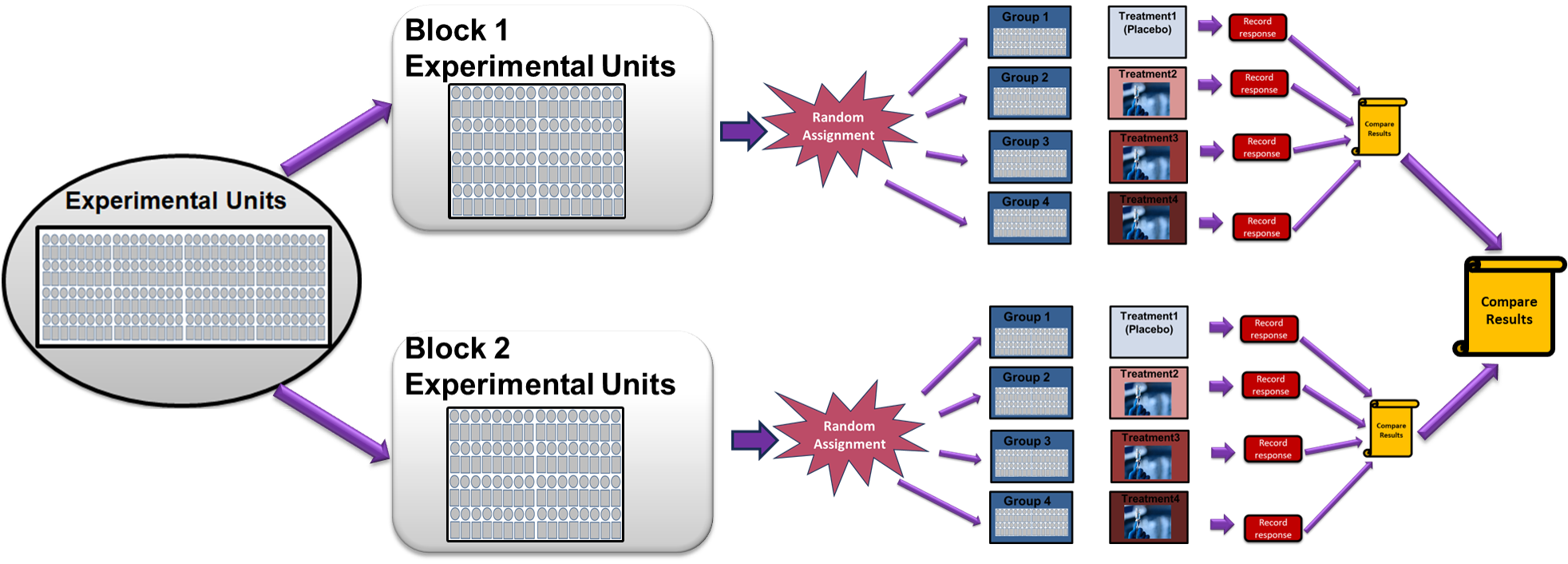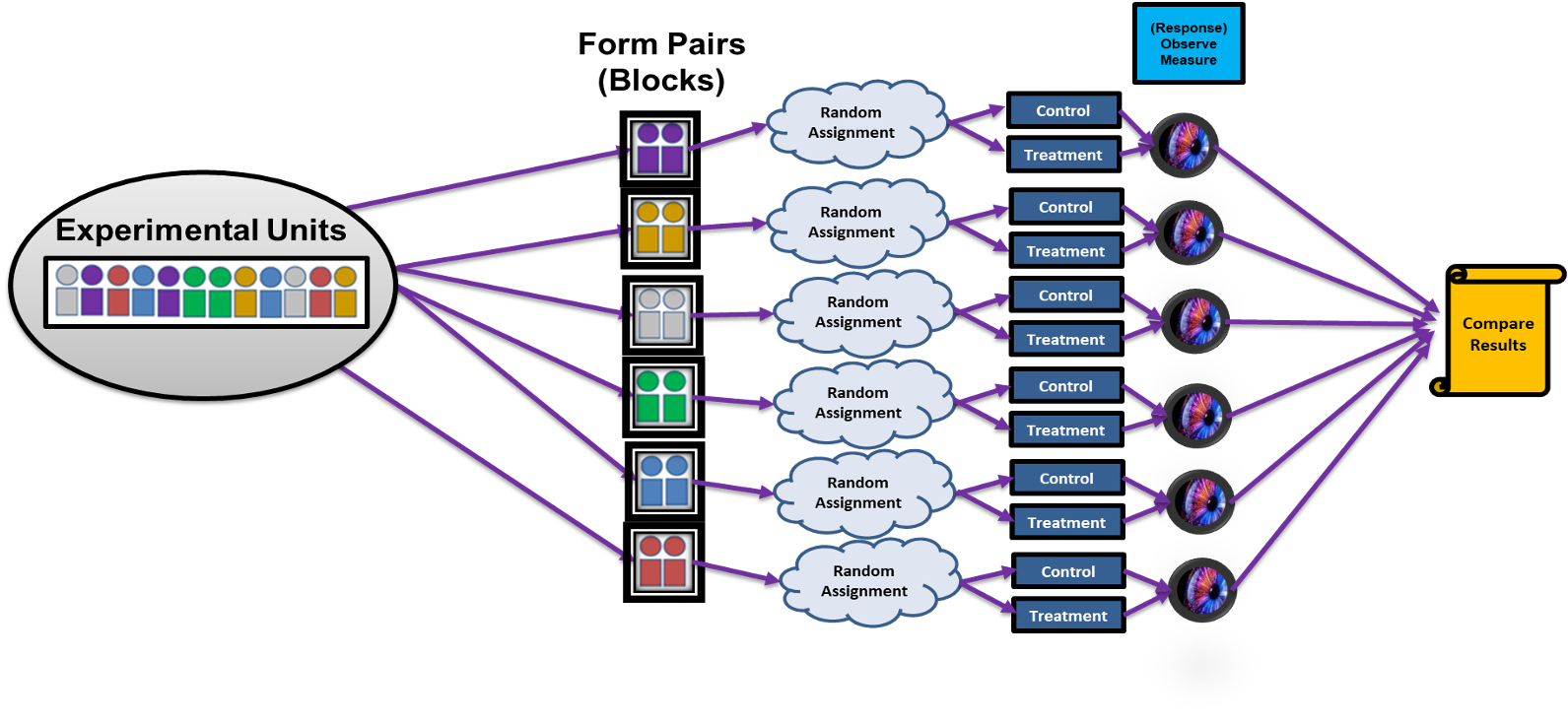Slides 📊
8.3. Basic Types of Experimental Design
Experimental designs provide structured templates for arranging experimental units, assigning treatments, and collecting data in ways that uphold the three principles of experimental design while addressing specific research challenges.
The three designs we will examine are among the most fundamental. Although more complex designs exist for specialized situations, these basic frameworks can address a wide range of research questions and form the foundation for understanding more advanced approaches.
Road Map 🧭
Understand the structure of the three most fundamental types experimental design: Completely Randomized Design, Randomized Block Design, and Matched Pairs Design.
Identify the advantages and limitations of each design, and select the most appropriate type for a given research setting.
8.3.1. Completely Randomized Design (CRD)
The Completely Randomized Design (CRD) represents the most straightforward application of experimental principles. In a completely randomized design, each unit has an equal chance of being randomly assigned to a treatment group.
Implementation

Fig. 8.4 Completely Randomized Design
Let’s walk through implementing a CRD with a concrete example. Suppose we want to test the effects of four different medications on the blood pressure of 40 healthy adults.
Step 1: Identify experimental units and determine the treatment groups. The experimental units would be the 40 human participants. The treatment groups are:
Group 1: Control (placebo)
Group 2: Low dose medication
Group 3: Medium dose medication
Group 4: High dose medication
Step 2: Randomly assign each participant to one of the four groups. We can use a simple procedure like rolling a four-sided die or use computer-generated random numbers.
Step 3: Apply Treatments.
Step 4: Measure Responses. Record blood pressure measurements according to a consistent protocol.
Step 5: Compare Results.
Advantages and Limitations of CRD
Advantages |
Limitations |
|---|---|
|
|
8.3.2. Randomized Block Design (RBD): Controlling Known Variability
When we know that certain extraneous characteristics of our experimental units strongly influence the response variable, Randomized Block Design (RBD) provides a method for controlling this variability while still maintaining the benefits of randomization.
Recall that blocking is a techinque of grouping experimental units into subgroups (blocks) based on shared characteristics. By blocking, we remove the effect of the extraneous variable from our comparison of treatments.
Implementation

Fig. 8.5 Randomized Block Design
Step 1: Identify the blocking variable. Choose a characteristic that is not the primary focus of the study but strongly influences the response variable.
Step 2: Form blocks. Group experimental units into blocks based on the blocking variable. Each block should contain units that are similar with respect to this characteristic.
Step 3: Randomize within blocks. This is equivalent to conducting a separate completely randomized design within each block.
Step 4: Apply treatments and measure responses.
Step 5: Analyze results. Compare treatments while accounting for block effects.
Example 💡: Testing Pain Medications 💊
Consider testing a new pain medication. If it is known that age significantly affects both baseline pain levels and response to medication, we can choose to create blocks based on age groups.
Block 1: Ages 18-30 (young adults)
Block 2: Ages 31-50 (middle-aged adults)
Block 3: Ages 51-70 (older adults)
Within each age block, randomly assign participants to receive either the new medication or a placebo. This ensures that each treatment is tested across all age groups, while controlling for the known effect of age on pain response.
Advantages and Limitations of RBD
Advantages |
Limitations |
|---|---|
|
|
8.3.3. Matched Pairs Design: Maximum Control
Matched Pairs Design represents the extreme end of the blocking spectrum, where we create the smallest possible blocks—typically containing just two experimental units that are nearly identical with respect to important characteristics.
Type 1: Separate Units in Pairs
In this approach, we identify pairs of experimental units that are extremely similar and randomly assign different treatments to the units in each pair.
Example 💡: Examples of Natural Pairs
Identical twins in medical or behavioral research
Litter mates in animal studies
Adjacent plots in agricultural research
Matched patients with very similar demographic and clinical characteristics
Paired manufacturing units from the same production batch
Implementation of Type 1 Matched Pairs Design

Fig. 8.6 Type 1 Matched Pairs Design
Step 1: Identify matching criteria based on variables that strongly affect the response.
Step 2: Form pairs of units that are nearly identical on these criteria.
Step 3: Randomly assign one member of each pair to one treatment, the other to another.
Step 4: Apply treatments and measure responses.
Step 5: Analyze pair differences.
Advantages and Limitations of Type 1 Matched Pairs Design
Advantages |
Limitations |
|---|---|
|
|
Type 2: Self-Pairing
In self-pairing designs, each experimental unit serves as its own comparison by receiving two treatments in a randomized order, typically separated by a washout period.
Implementation of Type 2 Matched Pairs Design

Fig. 8.7 Type 2 Matched Pairs Design
Suppose a researcher wants to compare two pain medications.
Step 1: Randomly assign either Medication A or B to each subject.
Step 2: Each unit takes the first medication for two weeks with daily pain ratings.
Step 3: Each unit enters a washout period of one week with no medication.
Step 4: The second medication is taken for two weeks with daily pain ratings.
Step 5: Compare results within each person.
Preventing the Carry-Over Effect
When the first treatment’s effects persist and influence the results of a subsequent treatment, this is called the carry-over effect. To minimize it:
Allow a washout period—enough time for the first treatment’s effects to fully dissipate before the next treatment.
Randomize treatment order so that not all units experience the same type of carry-over effects.
Some treatments have permanent or very long-lasting effects that make self-pairing inappropriate. For example,
Surgical procedures cannot be “undone”.
Educational interventions create lasting learning.
Some medications have effects that persist long after discontinuation.
Behavioral interventions might create permanent attitude or skill changes.
In these cases, Type 1 matched pairs is the only viable option.
Advantages and Limitaions of Type 2 Matched Pairs Design
Advantages |
Limitations |
|---|---|
|
|
8.3.4. Choosing the Right Approach
Selecting the appropriate experimental design requires balancing statistical considerations, practical constraints, and research objectives. Each design offers different advantages and faces different limitations.
Guidelines for Design Choice |
|
|---|---|
Choose CRD when: |
|
Choose RBD when: |
|
Choose Matched Pairs Design when: |
|
8.3.5. Bringing It All Together
Key Takeaways 📝
The three basic designs—Completely Randomized Design, Randomized Block Design, and Matched Pairs Design—serve as building blocks for most experimental approaches.
Design choice depends on the homogeneity of experimental units, known sources of variability, sample size constraints, and research objectives.
CRD provides simplicity and flexibility but works best with homogeneous units and adequate sample sizes.
RBD controls known variability through blocking, increasing precision and efficiency when strong blocking variables exist.
Matched pairs design maximizes control but requires either natural pairs or reversible treatments with adequate washout periods.
Exercises
Design Selection: For each research scenario, identify which of the three basic designs would be most appropriate and explain your reasoning.
Testing whether a new fertilizer increases crop yield using 60 plots of land that vary substantially in soil quality.
Comparing the effectiveness of three different teaching methods using 90 students of similar academic background.
Evaluating whether a new sleep medication reduces insomnia using 40 patients with chronic sleep disorders.
Testing whether background music affects concentration using 24 volunteers.
Blocking Variables: A researcher wants to test whether a new exercise program reduces blood pressure. Identify three potential blocking variables and explain why each might be important to control.
Matched Pairs Feasibility: For each scenario, determine whether Type 1 (separate pairs) or Type 2 (self-pairing) matched pairs design would be more appropriate, or if matched pairs design is not feasible.
Testing two different surgical techniques for knee repair
Comparing two methods for memorizing vocabulary words
Evaluating two different crop varieties for yield
Testing whether meditation reduces anxiety levels
Design from Scratch: Design a complete experiment to test whether background music affects concentration during studying using one of the three templates introduced in this section. Clearly identify all the components of an experiment and explain how the design addresses all three principles of experimental design.